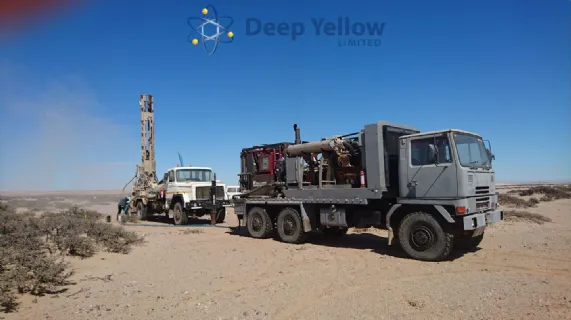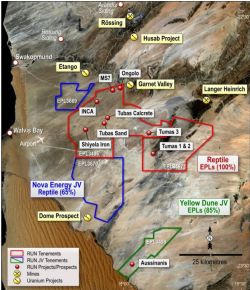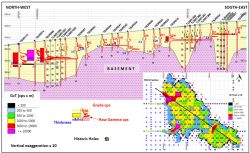
New Uranium Discovery Confirmed at Tumas 3, Namibia
Perth, May 22, 2017 AEST (ABN Newswire) - Deep Yellow Limited ( ASX:DYL) (
ASX:DYL) ( DYLLF:OTCMKTS) (DYL) is pleased to report continued encouraging drilling results from the 10,000m drilling program currently underway on EPL3496, held by DYL's wholly-owned subsidiary Reptile Uranium Namibia (Pty) Ltd (RUN) (see Figure 1 in the link below).
DYLLF:OTCMKTS) (DYL) is pleased to report continued encouraging drilling results from the 10,000m drilling program currently underway on EPL3496, held by DYL's wholly-owned subsidiary Reptile Uranium Namibia (Pty) Ltd (RUN) (see Figure 1 in the link below).
Key Points
- Drilling at Tumas 3 has extended uranium mineralisation over a 1.9km strike and remains open to the west and east
- High drilling success rate with 128 out of 144 holes (100m by 100m spacing) returning positive results including:
o 12m at 1,239ppm eU3O8 from 5.1m
o 12m at 1,163ppm eU3O8 from 6.1m
o 14m at 999ppm eU3O8 from 6.1m
- Mineralisation is calcrete associated and hosted in palaeochannels, similar to the Langer Heinrich uranium mine located 30km to the north east
- Planned 10,000m drill program approximately 40% complete and maiden resource for Tumas 3 discovery expected in the September quarter
The ongoing drilling of the Tumas 3 target zone has delineated additional uranium mineralisation, significantly extending the discovery since it was initially reported in April (see DYL ASX announcement 19 April 2017). Of the 144 vertical holes drilled for 3611m to 15 May 2017, 128 of these holes returned positive results - a very significant 88.9% success rate. This drilling has extended the palaeochannel associated mineralisation by 58% to 1.9km from the 1.2km previously reported. The Tumas 3 mineralisation still remains open, strongly justifying continued drilling and sourcing a second drilling rig to accelerate the program. Drilling is being conducted on a 100m x 100m spacing and on program completion is considered will be of sufficient resolution to estimate a maiden inferred resource in the September quarter.
This emerging discovery occurs as a distinct mineralised zone separate from the uranium resources the Company has identified within these palaeochannels in its Tumas 1 & 2 and Tubas Red Sands/Calcrete deposits (see Figures 1 and 2 in the link below). The palaeochannels occurring away from these deposits have only been sparsely drilled along widely spaced regional lines, leaving opportunity for both continuing the extension of Tumas 3 and for further discoveries within what can now be seen as an inadequately tested, highly prospective palaeochannel of 100km in length.
The mineralisation at Tumas is essentially blind in nature with no surface radiometric expression. Apart from the enormous benefit gained from the now more accurately defined palaeochannel systems as outlined in Figure 2 (see the link below), resulting from the re-interpretation of the existing airborne geophysical data to concentrate the exploration effort, actual discovery has only been possible by drilling.
eU3O8 ppm Determinations
In the Company's 19 April 2017 announcement advising of the Tumas 3 discovery, the mineralisation was referenced by the down-hole gamma counts per second (cps) giving only a semi-quantitative indication of the uranium presence. It was indicated in that release the eU3O8 determinations would follow once all necessary calibration factors were collected and verified for the conversion of cps to uranium grade.
The down-hole gamma data for 116 of the 144 holes drilled to 15 May 2017 have now been converted to equivalent uranium oxide values (eU3O8 ppm) and this work is confirming the ongoing encouraging results and the existence of an extensive mineralised system. The drilling has delineated a zone of continuous uranium mineralisation (see drill data results with eU3O8 determinations Table 1 in Appendix 1) (see the link below) with equivalent uranium grades ranging from 101ppm to 0.71% eU3O8 over 1m occurring within the 1.9km section tested to date of the 3km Tumas 3 target zone which the DYL is planning to drill in this current program. The mineralisation defined to date remains open to the west, north-west and south-east (see Figure 3 in the link below). Mineralisation has been defined as anything having a grade thickness (GT) of greater than 100ppm eU3O8 over a 1m interval as determined using a fully calibrated Auslog gamma down-hole logging unit. These GT values (eU3O8ppm x thickness in metres) are shown in contoured form in Figure 3 (see the link below) and highlight th e continuous, open nature of the uranium mineralisation. The results to date shows a robust mineralisation well within the norms of this style of uranium occurrence with average grade using a 100ppm eU3O8 cut-off being 358ppm and at a 200ppm eU3O8 cut-off rising to an average grade of 527ppm per metre comparing very favourably with the average grades of Langer Heinrich at similar cut-off grades.
The mineralised channel system that has been identified varies from 200m to 900m in width and ranges in thickness from 1m to 12m occurring at depths varying between 3m to 19m.
Analysis
The drilling continues to show that the Tumas 3 mineralisation is not confined to one simple, single channel but rather is associated with a complex palaeo-drainage system containing numerous intermingling channels heading westward toward the ocean. The drilling results indicate that the mineralised portion of the channel widens toward the west.
The original plan for the first phase of the current drilling program was to test a 3km section (to date only 1.9km tested) of the prospective palaeochannel at Tumas 3. However, should the strength and continuity of uranium mineralisation persist beyond the current 3km target zone, then this drilling program will be extended immediately to the west and east to delineate the full potential of what is emerging as a very significant exploration target. A second drill rig is currently being sourced in order to accelerate the current program. Drilling planned on the other targets (S Bend and S Bend East) that have been defined will accordingly need to be postponed.
Appendix 1 (see the link below) lists all 144 drill holes completed from commencement on 21 March 2017 to 15 May 2017 in Tables 1 and 2 (see the link below). Table 1 (see the link below) lists the 116 holes drilled to 3 May 2017 that have undergone eU3O8 determination and show depth and coordinates of the holes along with eU3O8 ppm values and the thickness of the mineralisation as calculated from down-hole gamma logging. Table 2 (see the link below) in Appendix 1 shows the additional 28 holes drilled between 3 May 2017 and 15 May 2017 for which eU3O8 determinations have not yet been calculated and uranium values are given semi-quantitatively in gamma counts per second (cps) from the down hole gamma logging also showing drill-hole locations, level of anomalous down hole gamma cps and thickness for each anomalous zone.
Drill hole cross sections (see Figures 4 and 5 in the link below) show the continuous, flat lying nature of the uranium mineralisation and also the variability and complexity of the palaeochannel topography.
Conclusion
The continuing positive drilling results from Tumas 3 again reinforce the strongly held belief of the new management and technical team that the palaeochannels occurring within the RUN held tenements present a valid and significant regional exploration target. These palaeochannels are showing they have previously been inadequately tested to the degree required, as evidenced by the discovery that has been made at Tumas 3. These new positive results, together with approximately 100km of prospective palaeo-drainage identified as still to be tested, provide management with increasing confidence that the existing uranium resource base within the Reptile project area can be increased.
To view tables and figures, please visit:
http://abnnewswire.net/lnk/83XMP55V
About Deep Yellow Limited
 Deep Yellow Limited (ASX:DYL) (OTCMKTS:DYLLF) is successfully progressing a dual-pillar growth strategy to establish a globally diversified, Tier-1 uranium company to produce 10+Mlb p.a.
Deep Yellow Limited (ASX:DYL) (OTCMKTS:DYLLF) is successfully progressing a dual-pillar growth strategy to establish a globally diversified, Tier-1 uranium company to produce 10+Mlb p.a.
The Company's portfolio contains the largest uranium resource base of any ASX-listed company and its projects provide geographic and development diversity. Deep Yellow is the only ASX company with two advanced projects - flagship Tumas, Namibia (Final Investment Decision expected in 1H/CY24) and MRP, Western Australia (advancing through revised DFS), both located in Tier-1 uranium jurisdictions.
Deep Yellow is well-positioned for further growth through development of its highly prospective exploration portfolio - ARP, Northern Territory and Omahola, Namibia with ongoing M&A focused on high-quality assets should opportunities arise that best fit the Company's strategy.
Led by a best-in-class team, who are proven uranium mine builders and operators, the Company is advancing its growth strategy at a time when the need for nuclear energy is becoming the only viable option in the mid-to-long term to provide baseload power supply and achieve zero emission targets.
Importantly, Deep Yellow is on track to becoming a reliable and long-term uranium producer, able to provide production optionality, security of supply and geographic diversity.
| ||
|










